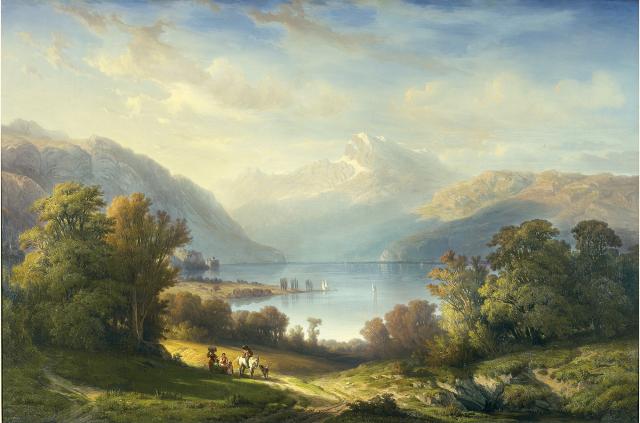By the mid-19th century, François Diday’s reputation, like that of his fellow painter Alexandre Calame, is at its height. When he paints Vue de Montreux, Chillon et Villeneuve (View of Montreux, Chillon and Villeneuve) in 1853, he has reached his maturity as an artist.
The selection of the site, the meticulous composition and the pictorial description built up by the artist’s patiently applied brushstrokes make plain the concern for realism. Faithfully depicted, the shore of Lake Geneva is wrapped in a very light veil of mist that harmoniously tempers the sunlight’s glare. The fusion of three elements, truth, balance and poetry, contributed to the success of a body of work that affirmed the then recent Swiss national identity.
In the 19th century, Alpine landscape painting is a new genre and quickly sparks a craze. In 1843, Rodolphe Töpffer, Geneva’s first art critic, publishes in the Bibliothèque universelle an article entitled “On the Alpine Landscape” which explains the new pictorial programme. Diday’s painting, elaborated according to the criteria set forth in Töpffer’s manifesto, breaks down into three distinct zones. A picturesque foreground displays the place where man lives, accompanied by animals and surrounded by trees which frame the composition. A second section is organised around mountains, with their imposing boulders and snow-bound peaks. Finally, the summits of the Alps and the immensity of the space surrounding them correspond, for Töppfer, to “the throne of the divinity”.
The selection of the site, the meticulous composition and the pictorial description built up by the artist’s patiently applied brushstrokes make plain the concern for realism. Faithfully depicted, the shore of Lake Geneva is wrapped in a very light veil of mist that harmoniously tempers the sunlight’s glare. The fusion of three elements, truth, balance and poetry, contributed to the success of a body of work that affirmed the then recent Swiss national identity.
In the 19th century, Alpine landscape painting is a new genre and quickly sparks a craze. In 1843, Rodolphe Töpffer, Geneva’s first art critic, publishes in the Bibliothèque universelle an article entitled “On the Alpine Landscape” which explains the new pictorial programme. Diday’s painting, elaborated according to the criteria set forth in Töpffer’s manifesto, breaks down into three distinct zones. A picturesque foreground displays the place where man lives, accompanied by animals and surrounded by trees which frame the composition. A second section is organised around mountains, with their imposing boulders and snow-bound peaks. Finally, the summits of the Alps and the immensity of the space surrounding them correspond, for Töppfer, to “the throne of the divinity”.
